In this post, we’ll look back at the story of the iMac, from its audacious birth to its impact on popular culture. We’ll cover its leaps in performance, its innovation, and the way it saved Apple from bankruptcy and made it the number one tech company on earth.
Whether you’ve been a fan for the last quarter century or just appreciate a good redemption story, there’s a chapter of the iMac’s history for you. But let’s start, like all good stories, at the beginning.
The Birth of the iMac, 1998 – 2001
Steve Jobs returned to Apple in 1997 after a long hiatus. The break allowed him to realize something fundamental – computers shouldn’t just be functional but attractive and user-friendly. The essence of Apple was always about melding technology with the liberal arts, creating products that not only worked but resonated on a deeply human level. The result? The iMac.
This innovative idea may be the most crucial concept in the last century. Jobs’s vision brought aesthetics to the forefront, making our devices not just tools but extensions of our style.
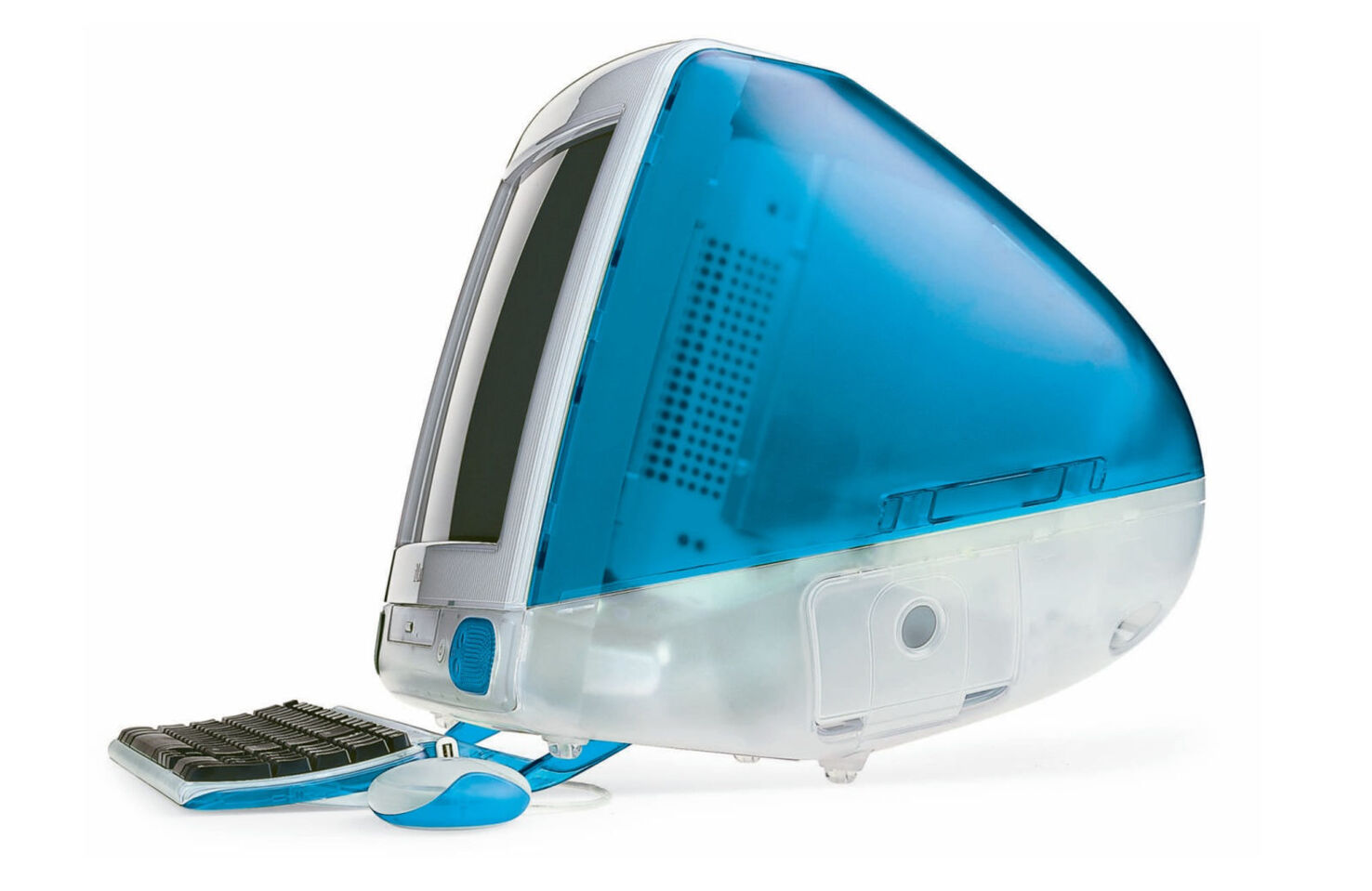
The Bondi Blue G3
The name might sound exotic, but the Bondi Blue G3 was nothing short of revolutionary. Housed in a translucent, egg-shaped case, this machine shattered the mold of beige boxes that flooded the 90s computer market.
Apple named this iconic design after the famous Bondi Beach in Australia, renowned for its clear waters and unique hue of blue.
The colorful, see-through design was more than just a fresh look; it represented transparency, simplicity, and a break from convention.
Dropping the Floppy for USB
Along with a new style came a new attitude that would continue to define Apple’s approach: the floppy disk was old, and USB was new, so Apple dropped the floppy.
The reason was clear: the future lay in universal connections. USB ports, back then, were a novelty, but Apple saw their potential:
- Speed: USBs were faster, offering quicker data transfer.
- Versatility: A single port type for multiple devices? Yes, please!
- The Future: Floppies had limited storage, and their days were numbered.
Today, we enjoy seamless connections between devices, and this daring move by Apple played a pivotal role in this universal compatibility we often take for granted.
iMac as an “Internet Machine”
Back in the ’90s, the internet was still a novelty — in fact, it was so new many predicted it was a fad that would die out before the year 2000.
Apple seized this trend with the iMac’s name – the “i” stood for the internet. They promised easy, out-of-the-box internet connectivity: no more complex setups or baffling configurations. Just plug in, power up, and you’re online.
The iMac made the internet easy for people who didn’t have the same kind of IT support that businesses enjoyed. Simplifying internet access made it possible for households to get online.
As a result, millions of kids who would never have encountered tech until they left for college started tinkering with the web.
At the heart of the iMac’s birth was a desire to push boundaries and redefine what a personal computer could be. Through design, innovation, and sheer audacity, Apple embarked on a journey that you, as a user, continue to be a part of with every device you power up.
The G4 Era, 2002 – 2004
The iMac G3 era featured various color options, including patterns. It seemed like Apple had a winning product design that would run for years, but Apple wasn’t about to rest on its laurels. Cue the G4 era, a period where Apple took another leap into the future, both in design and functionality.
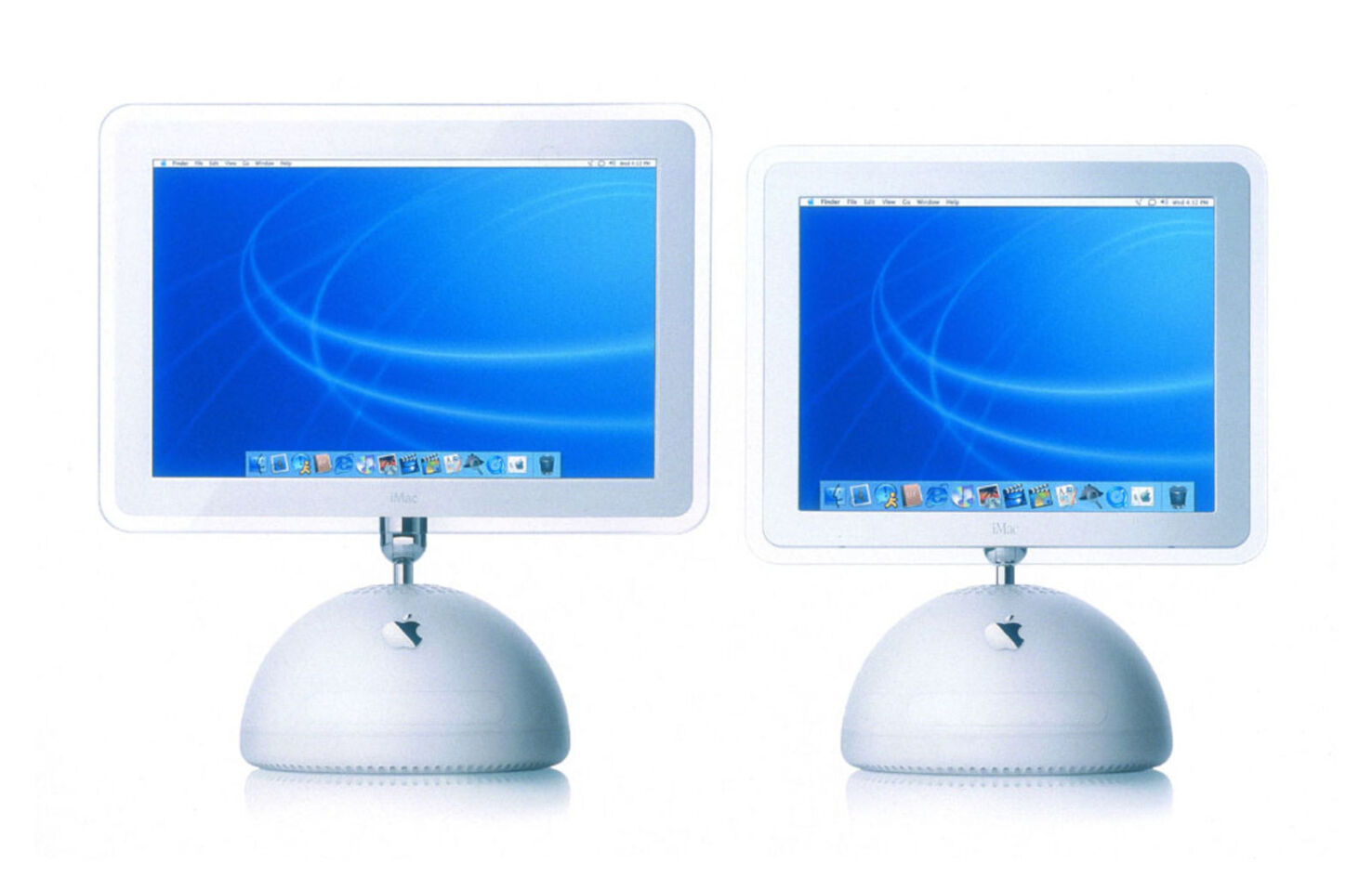
A Futuristic Design Transition
Move over egg-shaped designs; the iMac G4 was here to redefine chic! Reminiscent of a luxurious desk lamp, the G4 sported a flat-panel display mounted on a highly adjustable arm. This wasn’t just aesthetic brilliance; it was ergonomic innovation. This design allowed users to easily adjust the screen to their preferred viewing angle.
Anyone who owned a G3 iMac will remember stacking books to raise the viewport to a comfortable height. The G4’s adjustable arm was Apple’s early acknowledgment of user comfort. The company wasn’t just selling computers; they were selling an experience.
Performance Enhancement with the G4 Chip
If the design was groundbreaking, the G4 chip’s performance was earth-shattering. It boasted:
- Velocity Engine: An ability to handle 128 bits of data in a single cycle. (At the time, that was a lot.)
- Enhanced Multimedia: The chip excelled at complex tasks like image rendering and video processing.
- Increased Speeds: With speeds ranging from 350 to 500 MHz initially, later models would even touch 1.42 GHz.
Imagine running your modern apps on older processors – frustrating, right? The G4 chip was a blessing for those wanting to run multimedia applications without lag or hang-ups. It was all about giving you a smoother, faster experience.
The Introduction of the iLife Suite
Apple wasn’t just focusing on hardware; the software got some love, too. Apple introduced the iLife suite, bundling key multimedia applications:
- iPhoto: Your gateway to organizing, editing, and sharing photos.
- iMovie: Making movie editing accessible to everyone, not just professionals.
- GarageBand: Ever dreamed of creating music? This was your tool.
- iDVD and iWeb: Making DVD creation and website design more straightforward than ever.
Gone were the days when you needed tech expertise or professional software to get creative. With iLife, Apple democratized creativity. Whether you were a budding photographer, an amateur filmmaker, or someone who loved experimenting, iLife was your playground.
The G4 era was emblematic of Apple’s commitment to pushing the envelope. It wasn’t just about making another computer but about reimagining what computing could feel like. And if you were a user during this era, you didn’t just own a machine; you owned a piece of the future.
The G5 and Intel Transition, 2004 – 2007
Navigating the tumultuous waters of technological change is never easy, but Apple’s journey from the G5 to Intel is a testament to its ability to adapt, innovate, and redefine.
It was a little bumpy along the way — no one wants to buy an instantly obsolete computer, but Apple found intelligent ways to handle a very difficult change.
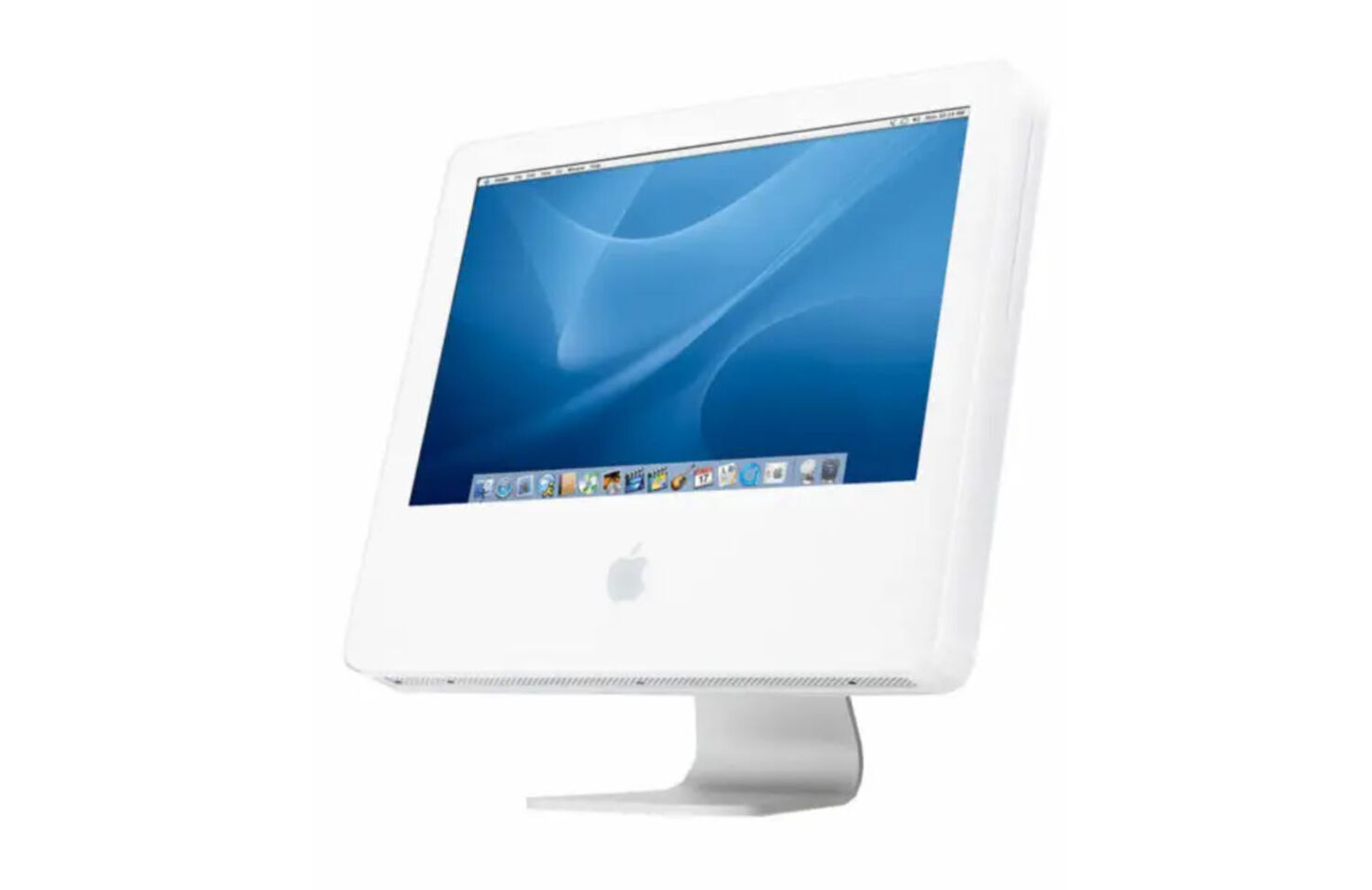
The All-in-One Design
But Apple wasn’t just stopping at the internals. The G5 iMac introduced the iconic all-in-one design. Sleek, minimalist, and incredibly modern. Far more in keeping with the original vision of the iMac as a single object.
At first, this design was created in polycarbonate, but it heralded the aluminum approach that Apple would adopt in a few short years.
The G5 introduced a faster, more streamlined computing experience. The G5 wasn’t just a powerhouse but a stylish addition to any desk or workspace.
Introduction of the G5 Chip
The G5 was a behemoth in its time. Apple touted it as the “world’s fastest personal computer,” and it didn’t disappoint:
- PowerPC 970: Built on the IBM PowerPC 970 architecture, the G5 offered 64-bit processing.
- Dual-Core Models: Some models sported dual cores, effectively doubling performance potential.
- Superior Graphics and Audio: Ideal for content creators and gamers alike.
The Shocking Intel Incident
No journey is without its challenges, and Apple faced a few with the G5:
- Heat Issues: The G5 was powerful but ran hot, leading to complicated cooling solutions.
- Limited Mobility: The heat and power consumption meant G5 wasn’t suitable for Apple’s laptops, which were borrowing iMac tech.
- Performance Plateau: There was only so much the G5 could offer in terms of speed and efficiency.
Enter Intel. In 2005, Steve Jobs made a historic announcement: Apple would transition to Intel processors. This was monumental. It wasn’t just a chip change but a complete shift in architectural direction.
Many Apple enthusiasts were horrified at the idea of adopting a PC processor.’ It’s no exaggeration to compare Apple’s Intel move with Dylan’s switch to electric guitar. But like Dylan, the switch opened Apple up to new heights of innovation.
Improvements in Software Compatibility and Performance with Intel
The switch to Intel was more than just hardware deep. The real magic lay in the software:
- Rosetta: A translation process allowed you to run older, PowerPC-based apps on new Intel Macs. Which meant your copy of Photoshop would keep working.
- Boot Camp: Ever wanted to run Windows on your Mac? Now you could, natively. At a time when Windows still got the majority of new software, this was a game-changer.
- Universal Applications: Developers began creating apps that worked on both PowerPC and Intel Macs, ensuring you didn’t miss out regardless of your machine.
The outcome? A smoother, more versatile user experience. Your iMac was now a symphony of compatibility, flexibility, and raw power.
The G5 to Intel transition was more than a technological evolution. It was a statement, a commitment to us, the users. Apple showed they weren’t afraid to make tough decisions to ensure we always had the best computing experience possible. And in this era, they proved it in spades.
The Aluminum Unibody Era, 2007 – 2015
In the ever-evolving tale of the iMac, the Aluminum Unibody era stands out for its technological advancements and commitment to design excellence. As aesthetics became a pivotal part of the tech conversation, Apple again rose to the occasion, ensuring you didn’t just have a machine – you had a lifestyle.
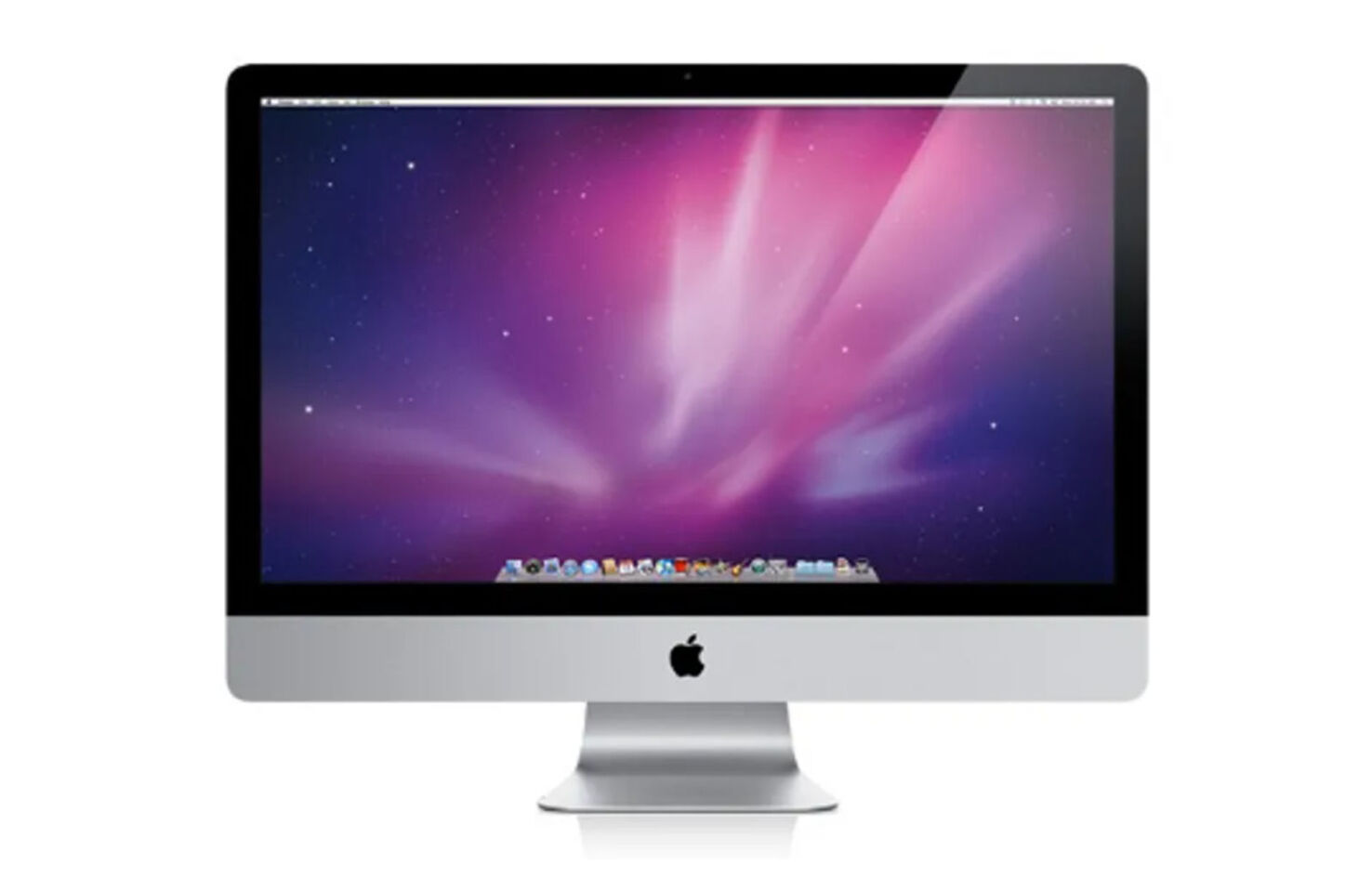
Thinner Design, Edge-to-Edge Glass, and LED Backlighting
The Aluminum Unibody iMac wasn’t just another computer; it was a work of art:
- Svelte Profile: Apple slimmed down the iMac’s chassis, making it sleeker and more modern.
- Edge-to-Edge Glass: Gone were the bulky bezels, replaced by a seamless edge-to-edge glass design that elevated screen immersion.
- LED Backlighting: Not only did this offer brighter, more vibrant visuals, but it also consumed less power and allowed for a thinner display.
iMacs of this era were visually stunning workhorses that didn’t compromise screen quality. It wasn’t just about getting tasks done; it was about enjoying every pixel of the journey.
Introduction of the Magic Mouse and Multi-Touch Trackpad
With the iMac’s design evolving, Apple knew the peripherals needed a facelift too:
- Magic Mouse: The world’s first multi-touch mouse, allowing you to swipe and scroll directly on its surface.
- Multi-Touch Trackpad: Borrowing from the iPhone’s playbook, this trackpad recognized gestures, transforming how you interacted with content.
Navigating your digital world with a flick, pinch, or swipe. Efficiency met elegance, and your fingertips were in control.
Enhanced Performance and Emphasis on Eco-Friendliness
Apple’s focus wasn’t solely on the external. The insides of the iMac got a boost, too:
- Performance Gains: Thanks to new processors and graphics cards, tasks were faster, and graphics more fluid.
- Greener Tech: The Aluminum Unibody iMac was PVC-free, BFR-free, and met ENERGY STAR 5.0 requirements.
- Recyclable Materials: Aluminum and glass, both highly recyclable, formed most of the iMac’s body.
Not only did you get a faster and more responsive machine, but you also made an eco-friendly choice. Every time you powered on your iMac, you were part of a greener tech revolution.
The Aluminum Unibody era showcased Apple’s dedication to pushing boundaries in form and function. For users, it redefined what it meant to own a computer. It was no longer just about specs and speeds but about style, sustainability, and a seamless experience.
The Retina Display Era, 2014 – 2022
Just when you thought the iMac couldn’t get any better, Apple ushered in the Retina Display Era, revolutionizing how we perceive and interact with digital content. We were immersed in high-resolution visuals like never before.
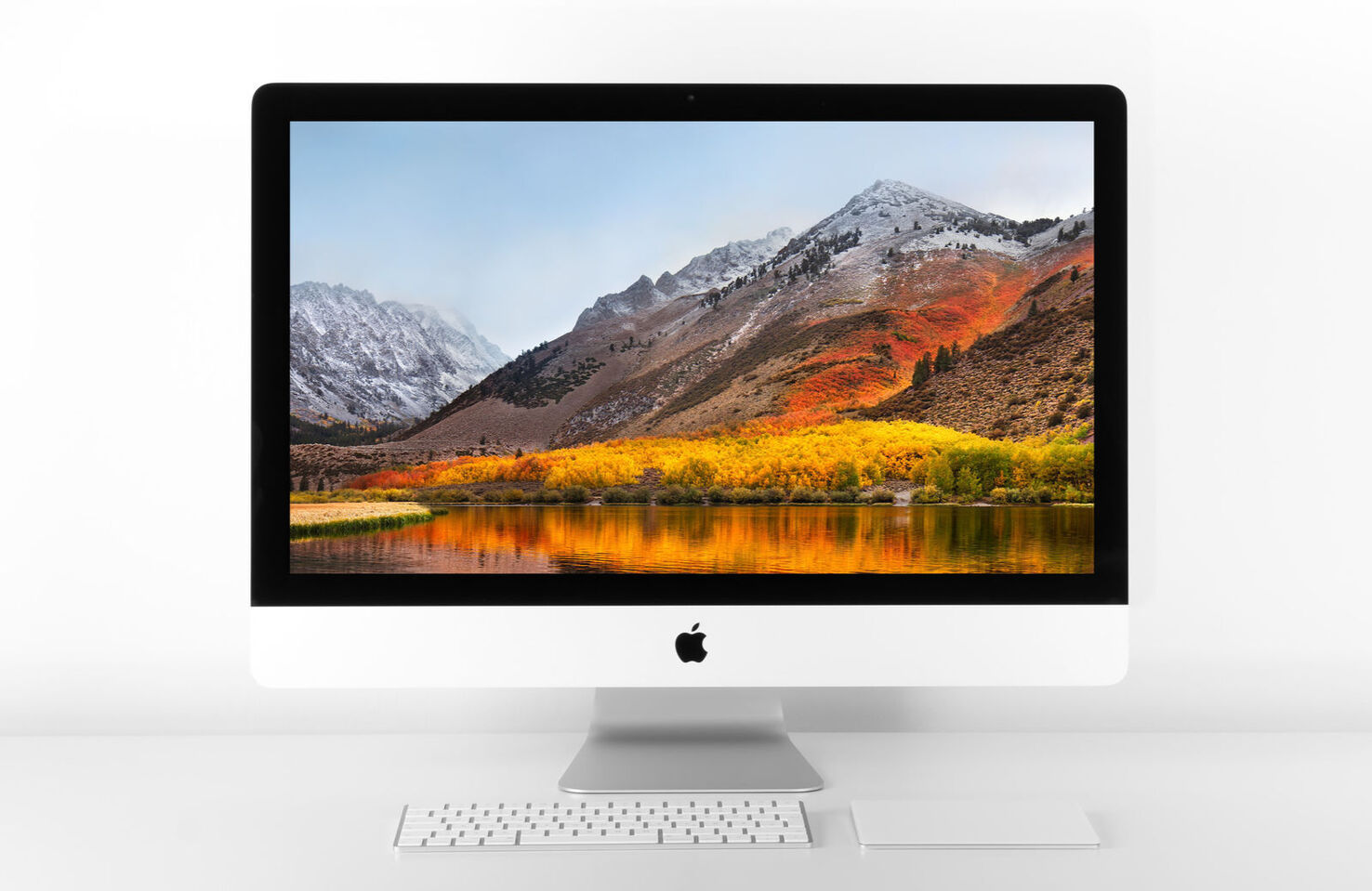
Introduction of Retina 5K Display: A Game-Changer in Visual Experience
Remember the first time you saw HD content and thought it was lifelike? The Retina 5K display took that sentiment and magnified it:
- Unparalleled Resolution: With 14.7 million pixels, it delivered visuals four times crisper than standard displays.
- Stunning Clarity: Text was razor-sharp, images boasted incredible detail, and videos became cinema-like experiences.
- Seamless Integration: Despite its prowess, the Retina display seamlessly integrated into the iMac’s slim design.
No more squinting or zooming in. Everything, from reading emails to editing photos, became a treat for the eyes. Pixels became a thing PC users worried about.
Enhanced Color Accuracy and Performance Boosts
But Apple didn’t stop at resolution:
- True-to-Life Colors: The Retina display showcased a wider color gamut, bringing more vibrant and accurate colors.
- P3 Color Space: This tech jargon translates to richer reds, deeper blues, and more responsive greens for you.
- Performance Tweaks: Behind this display were powerful processors and memory upgrades, ensuring smooth operations even with the most demanding tasks.
Whether you were a professional designer or just appreciated good visuals, the iMac now offered a canvas that truly replicated the natural world’s colors and nuances.
Focus on Content Creators with Improved Graphics and Processing Capabilities
Apple recognized a growing demographic: content creators. The iMac with Retina display was their love letter to this community:
- Powerful Graphics: GPUs capable of driving the Retina display while managing intense graphic workflows.
- Faster Processors: Multitasking, rendering, or just day-to-day operations, everything felt snappier.
- Optimized Software: Tools like Final Cut Pro and Photoshop were enhanced to make the most of the Retina display.
If you dabbled in content creation, be it video editing, graphic design, or photography, the iMac became your trusted partner. It paved the way for the creator economy and meant anyone could work with a professional-grade machine.
As the pages of the iMac’s story turned, the Retina Display Era marked a chapter where technology met artistry — this period signified a shift from mere computing to an era of visual marvels and unmatched creative potential. Every glance at the iMac was a reminder of how technology could elevate human experiences.
The M Chip Era, 2021 – 20??
As we venture into the contemporary chapter of the iMac’s journey, we find ourselves in an era of vibrant aesthetics, groundbreaking performance, and an interconnected Apple universe. The modern iMac isn’t just an update — it’s a revolution, embodying the future while nodding to its colorful past.
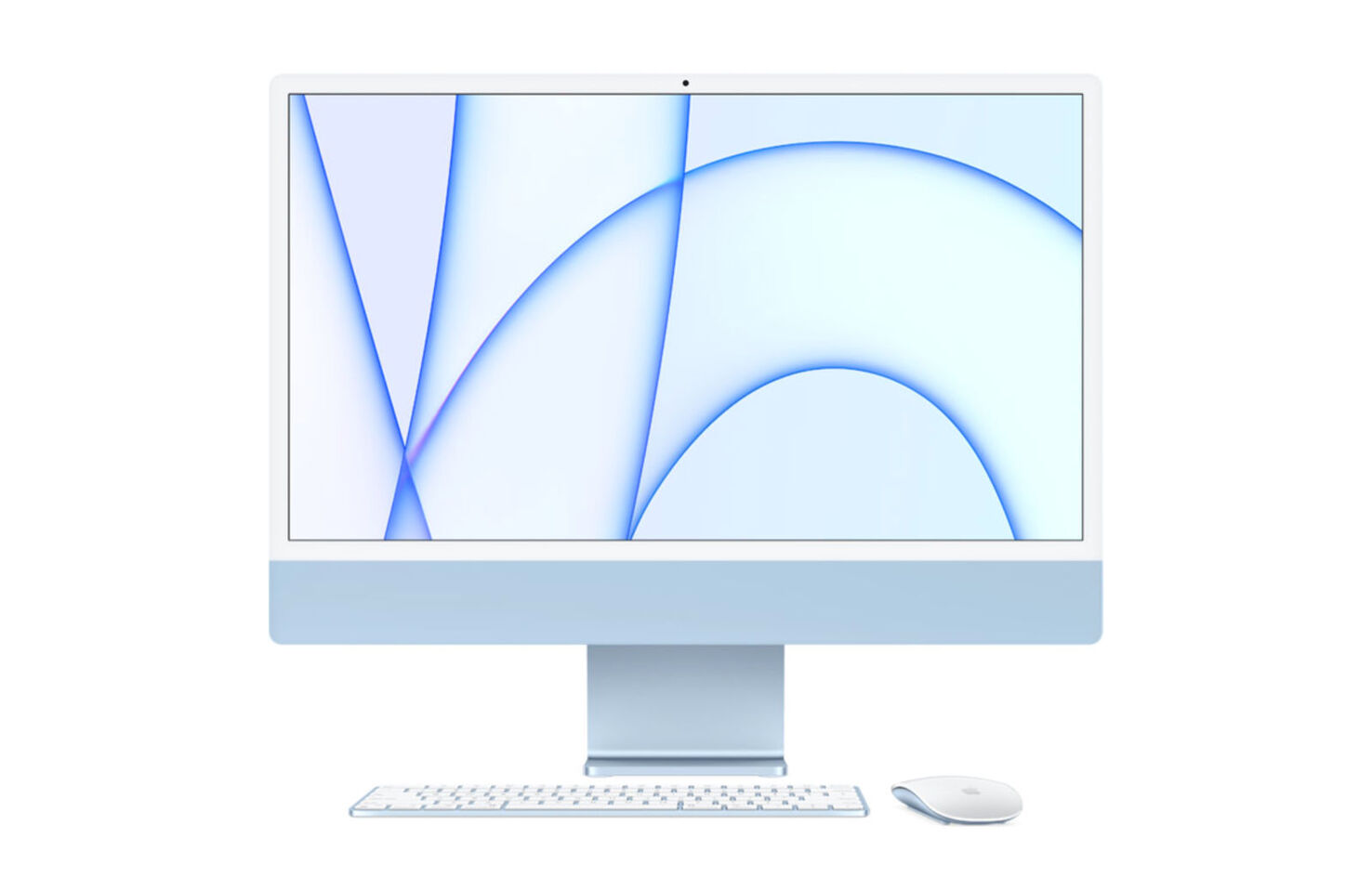
M1 & M2 Chip Integration
After the shock adoption of the Intel processor, Apple’s announcement of its own M1 (and, a couple of years later, M2 chips) is the final twist in the tale — so far.
Apple’s transition to its own chips is akin to a bird finally taking flight on its own:
- Blazing Speeds: Applications launch instantly, and tasks are completed before you know it.
- Integrated Design: By controlling both hardware and software, Apple ensures everything runs seamlessly.
The switch to Apple’s Silicon processors marks a seismic shift in computing prowess. Leaving Intel behind is a bold move that underscores Apple’s confidence in its innovation trajectory.
So far, it has paid off, with M1 and M2-powered Macs not just faster but noticeably faster than their older siblings.
Major Redesign with Thinner Profiles, Vibrant Colors
The modern iMac isn’t just an evolution; it’s a visual and technological marvel:
- Sleeker than Ever: An ultra-thin profile that makes it hard to believe it houses such power.
- A Nostalgic Palette: A splash of colors reminiscent of the original iMac but with a sophisticated, matte finish.
The current range iMac is not just functionally robust but a statement piece, adding a pop of personality to your workspace. It’s a noticeably snappier, more efficient computing journey, redefining what you expect from a desktop.
The Move Toward a Unified Apple Ecosystem
Apple’s vision isn’t limited to just one product; it’s about creating a harmonious digital environment:
- Universal Apps: Software that runs beautifully on your iMac, iPad, and MacBook, ensuring consistency across devices.
- Greener Computing: With Apple’s chips, the iMac consumes less power while delivering superior performance.
- One Apple Universe: With each product release, the lines blur, creating a seamless experience whether you’re on your iMac, iPhone, or Apple Watch.
It’s not just about using a device; it’s about living in an intuitive, interconnected, and incredibly user-friendly ecosystem.
With the modern iMac, Apple isn’t just offering a computer; they’re gifting you an experience. It blends the past’s nostalgia with the future’s promise. As you power it on, you’re not just starting a device but stepping into a brighter, more colorful, and incredibly efficient digital future. Welcome to the new age of computing!
The Cultural Impact of the iMac
Beyond the technical specs and design marvels, the iMac has left an undeniable cultural imprint on the world. You’ve likely felt it, too, even if you haven’t realized it. The ripples of its influence have touched not just the tech realm but our daily lives, popular culture, and the broader zeitgeist.
Changing Workspaces Forever
Before the iMac, computers were often large, bulky, and, let’s face it, unattractive. The iMac changed all that:
- Design-Forward: Suddenly, computers were chic, sleek, and something you wanted to showcase, not hide.
- Workspace Revolution: Open-plan offices and modern workspaces embraced the iMac as both a tool and a design piece.
- Personal Expression: With the iMac’s various colors and designs, your computer becomes an extension of your personality.
Your desk wasn’t just a workspace any longer. It became a style statement, a conversation starter, and a reflection of you.
Inspiring a New Generation of Creators
Apple’s focus on design and usability made technology more accessible and appealing:
- Democratizing Design: With its user-friendly interface and powerful tools, many budding designers and creators got their start on an iMac.
- Fueling Creativity: Think of the countless YouTube videos, podcasts, and digital artworks birthed from this machine.
- Spotlight on Accessibility: Apple’s commitment to inclusive design ensured everyone could create regardless of their abilities.
The iMac wasn’t just a machine; it was a muse, constantly nudging you to explore, create, and share.
Shaping Popular Culture
The iMac’s iconic design and features made their way into movies, TV shows, and even the music world:
- Hollywood’s Favorite: Whether it’s a futuristic sci-fi scene or a modern-day office drama, the iMac often plays a starring role.
- Trendsetter: The colorful iMac G3s became cultural symbols of the late ’90s and early 2000s.
- Influence on Competitors: Many tried (and failed) to emulate the iMac’s unique blend of form and function.
Whenever you spotted an iMac in a movie or TV show, it was a little nod to a shared cultural moment, a silent acknowledgment of its iconic status.
The iMac didn’t just change how we compute; it changed how we perceive technology in our cultural landscape. It’s not just about bits and bytes, pixels and processors. It’s about the stories, emotions, and connections the iMac has fostered over the years.
The iMac’s Remarkable Story
From its birth as an outsider to reigning as a design classic, the iMac’s journey is nothing short of legendary.
Web designers, creatives, and everyday users: we all became smitten. Its blend of aesthetics and capability made it not just a tool but a partner in our digital endeavors.
As you boot up your iMac, remember you’re not just using a computer; you’re interacting with a cultural icon. 🖥️✨
Simon Sterne
Simon Sterne is a staff writer at WebdesignerDepot. He’s interested in technology, WordPress, and all things UX. In his spare time he enjoys photography.
Source link



